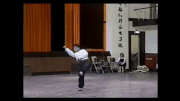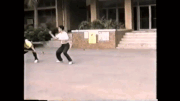Have you ever tried to punch without using your arm and just use your body (you may even put your arms behind our back)?
As long as your power generation come from
- bottom (feet) -> up (hip/waist),
- back (spine) -> front (chest/shoulder),
your power will finally reach to your arm and fist. In other words, your arm movement is not that important.
This is the opposite of to "freeze your body and just punch your arm" training.
Here is an example that you use your body to do the "hammer fist". It may look over exaggerated, but it forces you to concentrate on your "body method" instead of your arm movement.
What's your opinion on this?

As long as your power generation come from
- bottom (feet) -> up (hip/waist),
- back (spine) -> front (chest/shoulder),
your power will finally reach to your arm and fist. In other words, your arm movement is not that important.
This is the opposite of to "freeze your body and just punch your arm" training.
Here is an example that you use your body to do the "hammer fist". It may look over exaggerated, but it forces you to concentrate on your "body method" instead of your arm movement.
What's your opinion on this?

Last edited:


